Transcript:
As sea levels rise along Bangladesh's coast, saltwater is seeping into farmland, destroying soil fertility. As a result, some farmers and families are moving to the big city of Dhaka in search of better opportunities.
It is one of many places around the world where drought, flooding, rising sea levels and other climate impacts are forcing people to move.
Huerta: “Most climate migrants move within their own countries. … Most of them move into cities, especially because there are more jobs, more housing, more opportunities.
Claudia Huerta works for C40 Cities, a global network of mayors taking climate action.
Her team collaborated on a report projecting climate migration trends in 10 cities, including São Paulo, Brazil; Accra, Ghana; and Dhaka.
Huerta: “By 2050, 8 million people are expected to move to the 10 cities studied in this report due to climate change.”
That's if climate pollution doesn't decrease dramatically in the coming years.
But research also shows that if the world is to meet the goals of the Paris Climate Agreement, millions fewer people will need to immigrate.
Huerta said this highlighted the urgent need for global climate action to reduce the number of people forced to leave their homes due to the effects of a warming world.
Report source: Sarah Kennedy/ChavoBart Digital Media
Only 28% of U.S. residents regularly hear about climate change in the media, but 77% want to know more. By 2025, you can show Americans more climate news.
